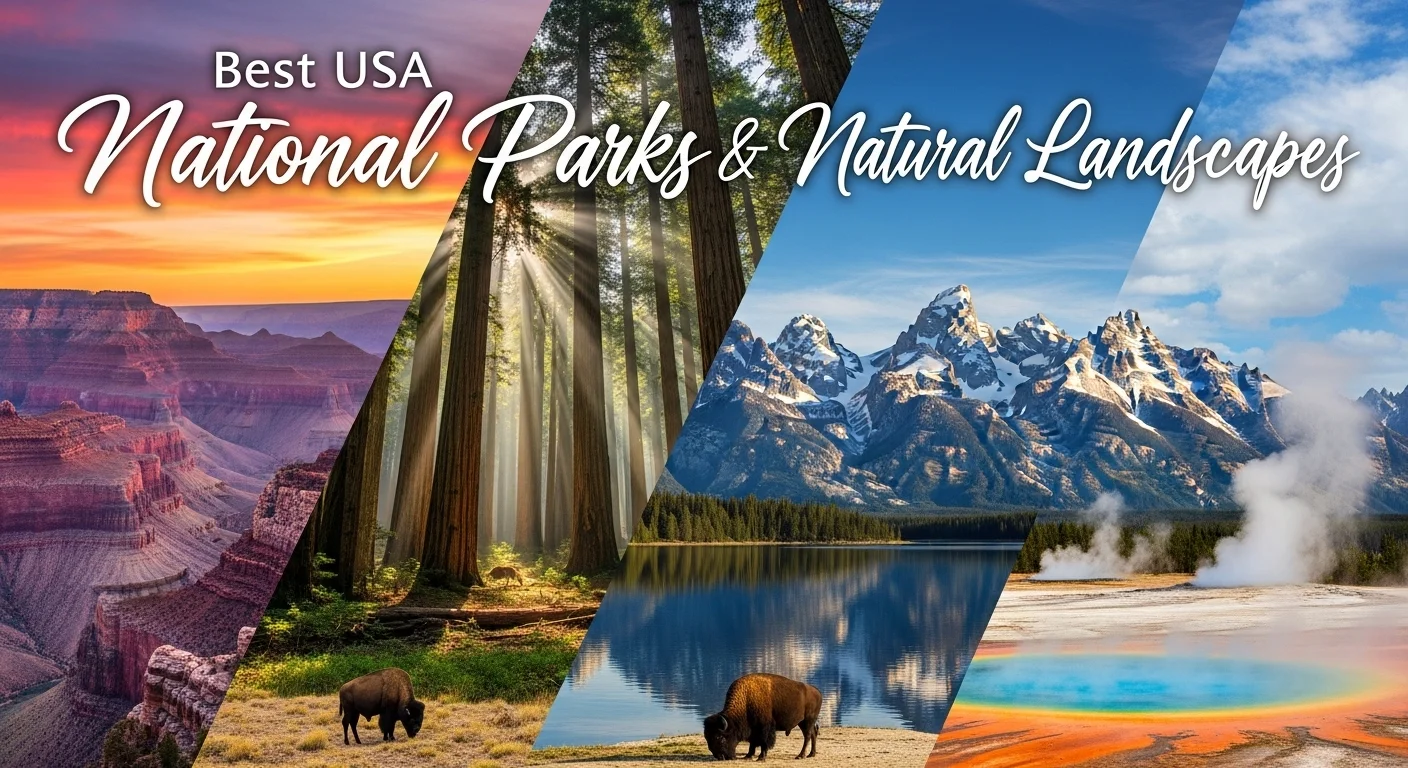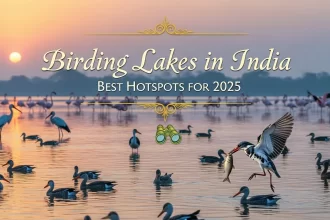Introduction: The Call of the Wild in 2025
As the world continues to buzz, the timeless allure of America’s untouched wilderness calls louder than ever. For nature lovers and landscape enthusiasts, the United States is a treasure trove of breathtaking diversity, from soaring mountain peaks and vast canyons to misty coastlines and erupting volcanoes. Crafting your travel bucket list for 2025 is an exciting endeavor, and it demands a guide to the most stunning USA National Parks and natural landscapes.
This curated list goes beyond just naming beautiful places. It’s your strategic planner for the year ahead, incorporating the latest on timed entry systems, travel trends, and essential tips to ensure your adventures are as seamless as they are unforgettable. Let’s explore the best nature vacations and scenic places the USA has to offer.
Why This List is Perfect for Your 2025 Plans
The way we explore US natural wonders is evolving. In response to overtourism, parks are implementing smarter management systems. The most significant trend for 2025 is the expansion of timed entry permits and reservation systems beyond the usual suspects. This isn’t meant to deter you, but to enhance your experience, ensuring trails and viewpoints remain pristine and accessible.
This guide is designed for the modern traveler who values sustainability, preparation, and authentic experiences. We’ve combined iconic American landscape photography spots with crucial 2025 planning tips to help you conquer your outdoor adventure travel goals responsibly and successfully.
The Ultimate 2025 Bucket List: 15 Must-See Parks & Landscapes
Here are the must-see natural attractions that deserve a top spot on your 2025 itinerary.
1. Yellowstone National Park: A Geothermal Wonderland
The world’s first national park remains one of the most thrilling US natural wonders. Witness Old Faithful erupt, marvel at the vibrant Grand Prismatic Spring, and watch for bison and wolves in the Lamar Valley.
-
The 2025 Update: Vehicle reservations for the peak season (expected April-October) are likely to continue. Secure these on Recreation.gov the moment they are released.
-
Don’t Miss: The otherworldly colors of the Grand Prismatic Spring from the Overlook Trail.
-
Pro Tip: Explore the less-crowded Lamar Valley for some of the best wildlife watching in the lower 48.
2. Yosemite National Park: The Granite Cathedral
Yosemite’s iconic vistas of El Capitan and Half Dome are legendary American landscape photography goals. Its towering waterfalls and ancient sequoia groves inspire awe in every visitor.
-
The 2025 Update: A peak-hours reservation system for park entry is anticipated to return for summer 2025. Always check the National Park Service (NPS) website for the latest mandates.
-
Don’t Miss: Tunnel View at sunrise, when the valley is bathed in golden light.
-
Pro Tip: Visit in late May or early June for the most powerful waterfalls.
3. Grand Canyon National Park: A Monumental Scale
No list of scenic places USA is complete without the Grand Canyon. This vast natural wonder offers perspectives from both the popular South Rim and the more remote North Rim.
-
The 2025 Update: The South Rim continues to be busy. Reservations for lodging and campsites inside the park are essential and book up a year in advance.
-
Don’t Miss: Hiking a portion of the South Kaibab Trail for unparalleled views into the canyon.
-
Pro Tip: For a unique perspective, consider a road trip to the North Rim, which is open seasonally and sees fewer visitors.
4. Zion National Park: Hiker’s Paradise
Zion’s sheer red cliffs and narrow slot canyons define the beauty of southern Utah. It’s a top destination for hiking trails and outdoor adventure travel.
-
The 2025 Update: The popular Angels Landing hike requires a permit won via a seasonal lottery. The shuttle system is mandatory for accessing the Scenic Canyon from spring through fall.
-
Don’t Miss: Wading through the Virgin River in the famous Narrows canyon.
-
Pro Tip: Apply for the Angels Landing lottery well in advance of your planned trip dates.
5. Glacier National Park: The Crown of the Continent
With its dramatic Going-to-the-Sun Road, pristine lakes, and active glaciers, Glacier is a must-see natural attraction. It’s a paradise for hiking and wildlife watching.
-
The 2025 Update: A vehicle reservation is required for Going-to-the-Sun Road, the North Fork, and Many Glacier areas during peak season. These are released months in advance on Recreation.gov.
-
Don’t Miss: The hike to Grinnell Glacier for stunning views of turquoise lakes and ancient ice.
-
Pro Tip: The road opening depends on snowfall; for the best access, plan your visit for July or August.
6. Acadia National Park: The Northeastern Jewel
Acadia offers a unique coastal experience on the rugged shores of Maine. Cadillac Mountain is one of the first places in the U.S. to see the sunrise.
-
The 2025 Update: Vehicle reservations for the Cadillac Summit Road are required from May through October.
-
Don’t Miss: Watching the sunrise from the summit of Cadillac Mountain.
-
Pro Tip: Enjoy popovers at the Jordan Pond House after a hike around the pond.
7. Arches National Park: A Red Rock Gallery
This Utah park contains over 2,000 natural stone arches, making it a surreal landscape photography destination.
-
The 2025 Update: Timed entry reservations are required from April through October. Book these as soon as they become available.
-
Don’t Miss: The delicate Delicate Arch, especially at sunset.
-
Pro Tip: Enter the park before 6 AM to avoid the timed entry requirement and experience the arches in the beautiful morning light.
8. Great Smoky Mountains National Park: Misty Mountain Majesty
As America’s most visited national park, the Smokies are famous for their blue-hazed mountains, diverse ecosystem, and rich Appalachian history.
-
The 2025 Update: While no park-wide entry reservation system exists, parking tags are required for any vehicle parked for longer than 15 minutes. The park is perennially crowded; planning is essential.
-
Don’t Miss: Driving the Cades Cove Loop Road for historic cabins, churches, and excellent wildlife watching (especially black bears).
-
Pro Tip: Visit during the weekdays to avoid the intense weekend traffic and crowds.
9. Hawaiian Volcanoes National Park: Land of Creation
Witness the raw power of nature on the Big Island, where two of the world’s most active volcanoes, Kīlauea and Mauna Loa, continue to shape the land.
-
The 2025 Update: Volcanic activity is constant and conditions change daily. Always check the official NPS website for volcano eruption updates, vent viewing availability, and air quality alerts before your visit.
-
Don’t Miss: Seeing the fiery glow of the Halemaʻumaʻu crater within Kīlauea Caldera after dark.
-
Pro Tip: Drive the Chain of Craters Road all the way down to the coast to see where past lava flows met the sea.
10. Kenai Fjords National Park, Alaska: Icy Wilderness
This park is where the Alaska wilderness meets the ocean. Vast glaciers carve through mountains and calve into fjords filled with marine life.
-
The 2025 Update: The Exit Glacier area is accessible by road, but to truly experience the park, you need a boat or kayak tour. These book up extremely fast for the short summer season.
-
Don’t Miss: A boat tour from Seward to see orcas, humpback whales, sea otters, and the thunderous sight of a glacier calving.
-
Pro Tip: Book your wildlife and glacier cruise several months in advance to secure a spot.
11. Antelope Canyon, Arizona: Nature’s Sculpture Gallery
Located on Navajo land, this stunning slot canyon is a world-renowned landscape photography destination, known for its wave-like structure and shimmering light beams.
-
The 2025 Update: Access is strictly controlled via guided tours only. The permit processes are handled by authorized Navajo tour companies. Book your tour well in advance, especially for the popular midday photography tours.
-
Don’t Miss: The mesmerizing light beams that pour into the upper canyon around midday, typically best in summer.
-
Pro Tip: Upper Antelope Canyon is easier to access, but Lower Antelope Canyon involves climbing ladders and offers a more adventurous experience.
12. The Wave, Arizona/Utah: A Geological Masterpiece
Located in the Coyote Buttes North area, The Wave is a surreal formation of swirling, striped sandstone. It is one of the most famous and difficult-to-see natural wonders in the U.S.
-
The 2025 Update: Access is granted to only 64 people per day via an extremely competitive online lottery system on Recreation.gov. A small number of advanced permits are available months ahead, and a daily lottery is held for next-day permits.
-
Don’t Miss: The entire Coyote Buttes North area, which contains other incredible formations like Melody Arch and The Second Wave.
-
Pro Tip: Apply for the lottery multiple times throughout your trip to increase your chances. The hike is strenuous and requires excellent navigation skills; come prepared with a map and plenty of water.
13. White Sands National Park, New Mexico: An Otherworldly Dune Field
This park features rolling white dunes of gypsum sand—the largest of its kind on Earth. It’s a fantastic place for sledding, photography, andstargazing.
-
The 2025 Update: The park is adjacent to the White Sands Missile Range, which occasionally closes the park for testing. Always check the park’s website or social media for alerts and closures before you go.
-
Don’t Miss: Staying for sunset when the dunes glow in brilliant pastel colors, and staying later for incredible stargazing in its designated dark sky park.
-
Pro Tip: Rent a plastic sled from the visitor center or bring your own for a fun and unique experience sliding down the soft dunes.
14. Bryce Canyon National Park, Utah: A Forest of Stone
Bryce is not a canyon but a series of massive natural amphitheaters filled with thousands of intricate hoodoos—tall, thin spires of rock that create a mesmerizing landscape.
-
The 2025 Update: Bryce Canyon is at a high elevation (8,000-9,000 feet), meaning it can be cold and snowy well into spring. The road to the farthest viewpoints (Rainbow and Yovimpa Points) is typically closed from November through April.
-
Don’t Miss: Sunrise at Sunrise Point or Sunset Point, where the hoodoos light up in fiery oranges and reds.
-
Pro Tip: Hike down into the amphitheater on the Queen’s Garden/Navajo Loop combination trail to walk among the hoodoos for a truly immersive perspective.
15. Olympic National Park, Washington: Three Parks in One
Olympic is an incredibly diverse must-see natural attraction, encompassing three distinct ecosystems: rugged Pacific coastline, temperate rainforest, and alpine mountains.
-
The 2025 Update: This is a massive park requiring significant drive time between sections. A road trip itinerary is a must. Check for road closures, especially on Hurricane Ridge, which can be affected by weather and construction.
-
Don’t Miss: The Hall of Mosses trail in the magical Hoh Rain Forest, and the sea stacks at Rialto Beach or Ruby Beach.
-
Pro Tip: Give yourself at least 3-4 full days to adequately experience the coast, the rainforest, and the mountains.
Your 2025 Planning Guide: Tips for a Successful Trip
Conquering your bucket list requires strategy. Here are essential planning tips for 2025:
- Reservations are Non-Negotiable: For many parks, spontaneity is not an option. Assume you need reservations for entry, parking, or specific hiking trails and book the minute they open.
- Book Lodging Far In Advance: Lodging inside parks sells out a year ahead. If sold out, look for gateway towns.
- Travel Off-Peak: For a better experience, visit during shoulder seasons (April-May and September-October). Crowds are thinner, and the weather is often ideal.
- Get an “America the Beautiful” Pass: For $80, this pass grants entry to all federal recreation sites for a year. If you visit more than three parks, it pays for itself.
- Practice Leave No Trace: This is crucial. Pack out all trash, stay on designated trails, and respect wildlife from a distance. Be a responsible traveler.
Conclusion: Start Dreaming, Start Planning
The diverse natural landscapes of the USA offer endless opportunities for exploration and wonder. From the geothermal spectacles of Yellowstone to the ancient volcanoes of Hawaii, these beautiful places in America are waiting to be checked off your bucket list.
2025 is your year to answer the call of the wild. Use this guide, do your research, plan meticulously, and embark on outdoor adventures that will create memories for a lifetime. The wilderness awaits.
Also Read: 18 Most Dangerous Hiking Trails in National Parks Across The Globe That Only True Adventurers Can Conquer
FAQs (Frequently Asked Questions)
Q1: Which national parks require reservations in 2025?
Ans: As of now, parks like Yosemite, Glacier, Arches, Rocky Mountain, and Zion (for Angels Landing) have systems in place. Always check the official NPS website for each park for the most current and accurate information for 2025.
Q2: What is the best time of year to visit these parks?
Ans: Spring and fall (“shoulder seasons”) are generally ideal for most parks, offering milder weather and fewer visitors than the crowded summer months. Always research your specific destination, as conditions vary greatly.
Q3: How can I avoid crowds in popular parks?
Ans: Arrive early (before 8 AM), stay late, hike more challenging trails, and visit less popular areas of the park. Weekdays are always quieter than weekends.
Thank you for trusting Outdoorkeeda as your guide for your international travel needs. 🙏







